
Keckiella corymbosa is a species of flowering shrub in the plantain family known by the common names redwood keckiella, red beardtongue, and red shrubby penstemon.

Nothochelone is a monotypic genus of flowering plants in the plantain family containing the single species Nothochelone nemorosa, which is known by the common name woodland beardtongue. Originally described as Penstemon nemorosus, the plant is very similar in appearance to the penstemons, but was separated and placed into its own genus on the basis of slight morphological differences, such as winged seeds.

Penstemon albomarginatus is an uncommon species of penstemon known by the common name white-margined beardtongue. It is native to the deserts of southern Nevada and western Arizona, as well as in two desert washes in the Mojave Desert in California. It is a perennial herb with several erect stems emerging from a taproot in the sand, their base buried beneath the surface. The stem branches are hairless and somewhat waxy in texture, reaching up to about 35 centimeters tall. The oppositely arranged leaves are oblong or widely lance-shaped, pale green edged in white, and up to 5 centimeters long. The inflorescence produces several purplish-pink tubular flowers between 1 and 2 centimeters long surrounded at the bases by toothed, white-edged sepals. The flower has some hairs in the mouth, but the staminode is hairless. The flowers are pollinated by vespid wasps and probably other insects, such as carabid beetles.

Penstemon filiformis is an uncommon species of penstemon known by the common name threadleaf beardtongue. It is endemic to the Klamath Mountains of northern California, where it grows in forest and woodland, often on serpentine soils. It is a perennial herb growing up to half a meter tall, its stem hairy and woody toward the base. The leaves are very narrow, linear and rolled to threadlike, reaching up to 7 centimeters long, those low on the plant sometimes borne in clusters. The inflorescence produces hairless, tubular or funnel-shaped blue to purple flowers just over a centimeter in length.
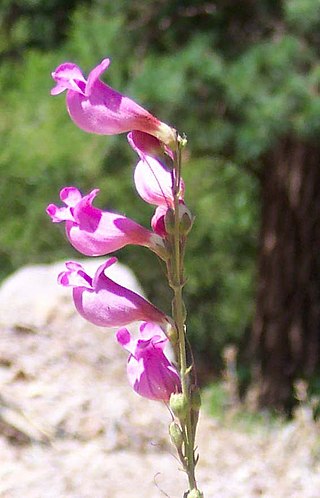
Penstemon floridus is a species of flowering plant in the plantain family known by the common names Panamint beardtongue and rose penstemon.
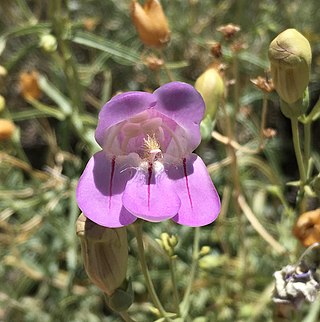
Penstemon fruticiformis is a species of penstemon known by the common name Death Valley beardtongue. It is native to the western United States, where it is found growing in rocky scrub, woodlands, deserts and mountains of eastern California and western Nevada. It is known from scattered occurrences around Death Valley, and only one of the two varieties occurs on the Nevada side of the border. It is a perennial herb producing spreading, multibranched, hairless and waxy stems 30 to 60 centimeters tall. The thick leaves are generally lance-shaped, folded and rolled, and up to 6.5 centimeters in length. The inflorescence produces several white or pale pinkish-lavender flowers between 2 and 3 centimeters long. The mouth of the flower bears a stark, dark line on each of its three lower lobes, nectar guides for its pollinators which probably include native bumble bees.

Penstemon gracilentus is a species of penstemon known by the common names slender beardtongue and slender penstemon. It is native to the mountains and sagebrush plateau of northeastern California, western Nevada, and southern Oregon, where it grows in forest, woodland, and scrub habitat. It is a perennial herb producing upright branches to about 65 centimeters in maximum height, the stems developing woody bases. The leaves are up to 10 centimeters in length and linear or lance-shaped. The glandular inflorescence produces several tubular purple flowers up to 2 centimeters long. The mouth of each flower may be hairless or coated in long hairs, and the staminode usually has a coat of yellow hairs.
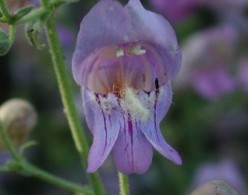
Penstemon grinnellii is a species of penstemon known by the common name Grinnell's beardtongue. It is endemic to California, where it can be found in several mountain ranges from those around the San Francisco Bay Area to the Sierra Nevada to the Peninsular Ranges near the Mexican border. It is a perennial herb producing upright stems growing to 85 centimeters in maximum height. The leaves are oblong, up to 9 centimeters in length, folded lengthwise and curved backward. The glandular inflorescence produces several tubular purple-tinged white or violet flowers 1 to 2 centimeters long. The mouth of the flower has three lower lobes streaked with dark lines, a hairy throat and a long-haired, protruding staminode.

Penstemon heterodoxus is a species of penstemon known by the common name Sierra beardtongue. It is native to California and western Nevada where it grows in several of the mountain ranges from the Klamath Mountains to the Sierra Nevada - and the slopes and plateaus to the east. It grows in subalpine and alpine climates in mountain forests, meadows and talus.

Penstemon incertus is a species of penstemon known by the common name Mojave beardtongue. It is endemic to California, where it can be found in many of the southeastern mountain ranges, including the southern reaches of the Sierra Nevada, the Tehachapis, and the mountains of the Mojave Desert region. It is a member of the flora in scrub and woodland, among Joshua Trees and in sandy washes.

Penstemon papillatus is a species of penstemon known by the common name Inyo beardtongue.
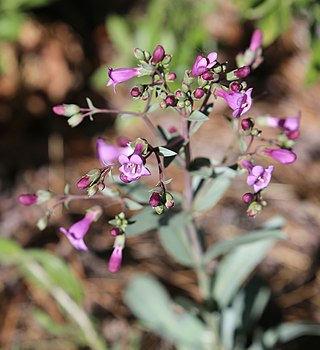
Penstemon patens is a species of penstemon known by the common name Lone Pine beardtongue. It is native to the central Sierra Nevada of California and slopes and plateau to the east, its distribution extending just into Nevada. It grows in forest, woodland, and scrub habitat types. It is a perennial herb producing hairless, waxy stems up to about 40 centimeters tall. The thick, lance-shaped, gray-green, opposite leaves are up to 9 centimeters long and 2 wide. There are usually many leaves clustered around the base of the plant and smaller pairs higher on the stem. The inflorescence bears wide-mouthed tubular flowers up to 2 centimeters long with corollas in shades of lavender to magenta. The flower is mostly hairless except for the staminode which may have a coat of orange or yellowish hairs.
Penstemon personatus is an uncommon species of penstemon known by the common name closethroat beardtongue.

Penstemon utahensis is a species of penstemon known by the common names Utah beardtongue and Utah penstemon. It is native to the southwestern United States, where it grows in scrub, woodland, and canyons. It is a perennial herb growing erect to a maximum height near half a meter. The thick leaves are located around the base of the plant and in opposite pairs along the stem. The upper leaves are lance-shaped and often folded lengthwise, measuring up to 5.5 centimeters long. The showy inflorescence bears many bright red-pink flowers up to 2.5 centimeters in length. They are cylindrical, tubular, or funnel-shaped with wide, lobed mouths, and mostly hairless to slightly hairy and glandular.

Penstemon rhizomatosus is a rare species of flowering plant in the plantain family known by the common names Scheel Creek beardtongue and rhizome beardtongue. It is endemic to Nevada in the United States, where it occurs only in the Schell Creek Range of White Pine County.

Penstemon degeneri is a species of flowering plant in the plantain family known by the common name Degener's beardtongue. It is endemic to Colorado in the United States, where it occurs in and around the Arkansas River Canyon in Fremont, Custer, and Chaffee Counties.
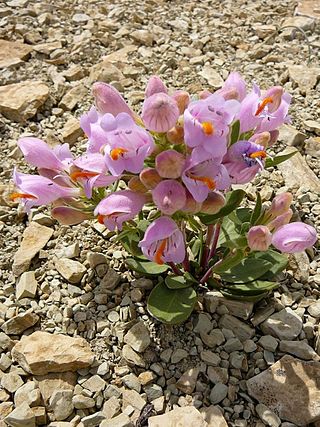
Penstemon grahamii, known by the common names Uinta Basin beardtongue and Graham's beardtongue, is a species of flowering plant in the plantain family. It is native to Utah and Colorado in the United States.
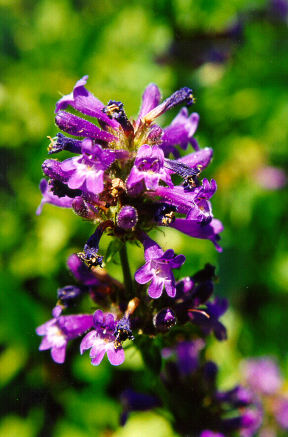
Penstemon attenuatus is a species of flowering plant in the plantain family known by the common names sulphur penstemon and taperleaf beardtongue. It is native to the northwestern United States.

Penstemon cyaneus is a species of flowering plant in the plantain family known by the common names blue penstemon and dark-blue beardtongue. It is native to the western United States, where it is widespread in Idaho, Montana, and Wyoming.

Penstemon eriantherus is a species of flowering plant in the plantain family known by the common names fuzzytongue penstemon and crested beardtongue. It is native to western North America, where it occurs in western Canada and the northwestern and north-central United States.




















